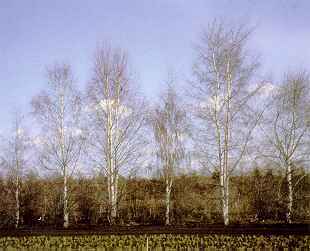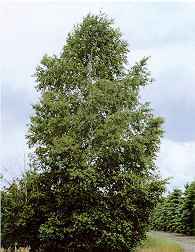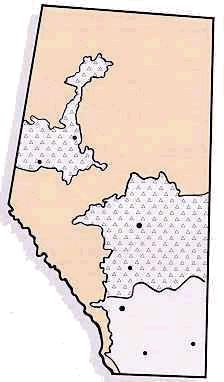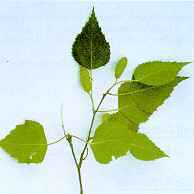| | Plant characteristics | Fall colour | Site preference | Hardiness | Uses | Problems | Insects | Pruning
.


Scientific Name: Betula papyrifera Marsh.
Plant Characteristics
White birch is a tall deciduous tree, growing to a mature height of 6 to 12 m (20 to 40 ft), with a spread of 6 m (20 ft). It has an annual growth rate of 10 to 45 cm (4 to 18 in.), with a useful life of 15 to 50 years.
Bark - Older bark has good ornamental value. It is white, papery, peeling in thin sheets after 4 to 6 years. The inner bark is reddish-orange, turning black with age.
Buds - Greenish-brown blunt or sharp pointed.
Flowers - Monoecious (male and female on same tree). Male catkins form in fall, remain naked over winter, and open in spring.
Fruit - Nutlet with membranous wings.
Leaves - Alternate, simple, ovate, coarsely serrate, usually somewhat pubescent on veins beneath, but glabrous above.
Propagated by seed.
Fall Colour
Leaves are yellow.
Site Preference
Plant white birch in full sun only; will not tolerate full shade.
It has a wide soil adaptation, tolerating acid sites, but does best on well-drained sandy or silty-loam soils with adequate moisture. Does poorly on dry sites. Needs some protection from winds.
Hardiness
Hardy to Arctic Circle.
.

Uses
Accent plant, shelterbelt, lawn specimen. In shelterbelt situations white birch should be planted 1 to 3 m (3 to 10 ft) between trees in the row and 5 to 8 m (17 to 26 ft) between rows.
Problems
Winter dieback from desiccation and root injury. Does not tolerate high temperatures. Roots are particularly susceptible to death due to high soil temperatures.
Insects
Birch leaf miner
Birch twig borer
Sapsucker
Pruning
Pruning to remove dead, diseased or broken branches should be done soon after leaves develop. This will avoid "bleeding" from pruning wounds. Usually develop single stem.
.

Shelterbelts Varieties for Alberta provides information on a number of other trees and shrubs than may be suitable for shelterbelts.
Visit our website directory for the Reforestation Woodlot Listings. |
|